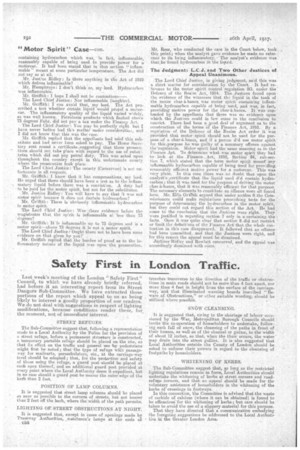Safety First in London Traffic.
Page 20

If you've noticed an error in this article please click here to report it so we can fix it.
Last week's meeting of the London " Safety First" Council, to which we have already briefly referred, had before, it an interesting report from its Street Dangers Sub-Committee. We have extracted those portions of the report winch appeal to us as being likely to interest a goodly proportion of our readers.. We do not deal with suggestions in respect of lighting modifications, because conditions resider these, for the moment, not of immediate' interest.
STREET REFUGES.
Tile Sub-Committee suggest that, following. a representation made to a Local Authority by the Police for the provision of a street refuge, before a permanent struature is constructed, a temporary portable refuge shOuld be placed on the site, so that its effect on the traffic and general use (by -pedestrians might first he noted; that the type of refuge with passageway for mailcarts, perambnlators, etc., at the carriage-way level should be adopted; that, for the proteetion and safety of those using the refuge, a guard post should be placed at' each apex thereof, and an additional guard post provided at every point where the Local Authority deem it expedient, but in no case should a guard post be nearer the outer edge of the kerb than 2 feet.
POSITION OF LAMP COLUMNS.
It is suggested that street lamp columns should be placed as near as possible to the corners of streets, but riot nearer than 2 feet off the kerb, where the width of the path permits.
LIGHTING OF: -STREET OBSTRUCTIONS AT NIGHT.
It is suggested that, except in cases of openings made by Tramway Authorities, _watchmen's lamps at the ends of c68
trenches traesverso to the direction of the traffic or obstructions in main roads should not he more than 4 feet apart, nor more than 4 feet in height from the surface of the carriageway, and that illuminated warning boards inscribed "Beware of Obstructions," or other suitable wording, should be utilized where -possible.
• SNOW -CLEANSING. •
• It is suggested that, Owing to theeshortage of labour ocCasioned 'by the -War, Metropolitan Borough -Councils should invite 'the co-operation of thouseholders to undertake' following each fall of snow, the cleansing ef the paths in front of their houses, as well es of the channel or gutter, to the width of about 12 inches, so that, when the thaw occurs, the water' may drain into the street gullies. It is also suggested that Local Authorities outside the County of London should be asked to enforce their powers in regard to the cleansing of footpaths by householders.
. WHITENING OF KERBS.
The Sub-Committee suggest that, go long as the restricted lighting regulations remain in force, Local Authorities should undertake the 'whitening of kerbs at street corners and 'roadrefuge corners, and that an apneal should be made for the voluntary aSsistance of householders in the whitening of the kerbs of crossings in footways. . In this connection, the Committee is advised that the waste of carbide of calcium (where it can be obtained) is found to be efficacious-for the whitening of kerbs; but care should be taken to avoid the use of a slippery material for this purpose.
That they have directed that a coisurnmication embodying the foregoing.suggestions be addressed to the Local Authorities in the Greater London Area.
























